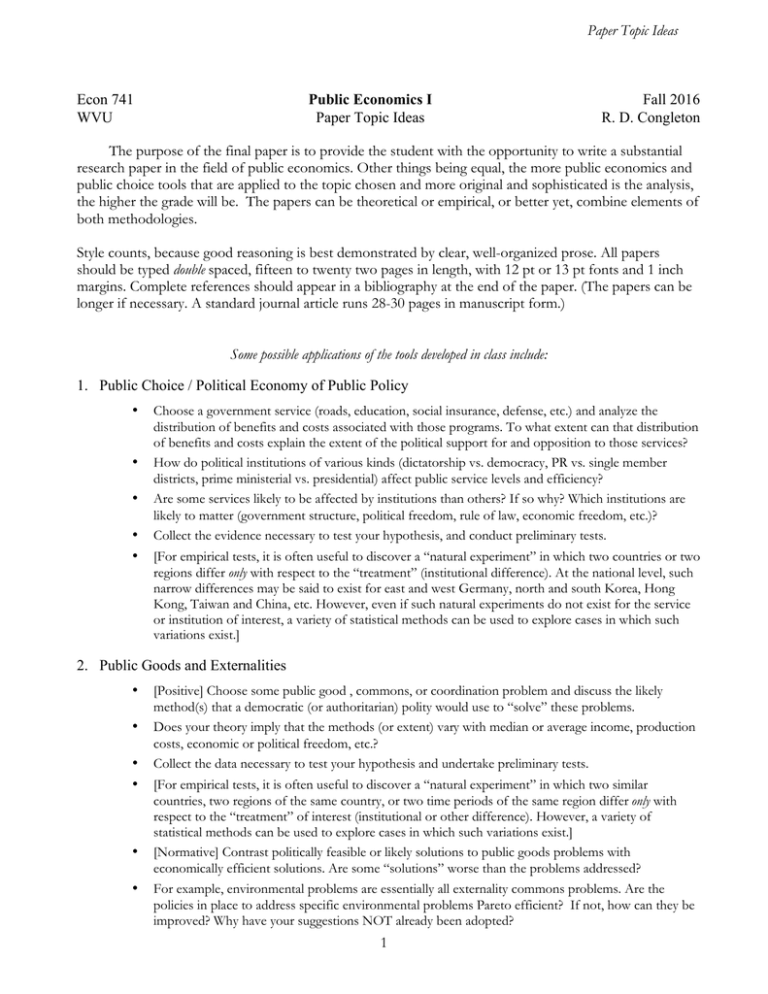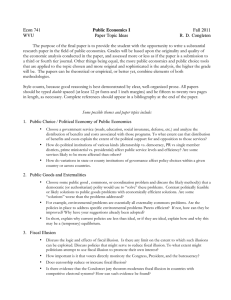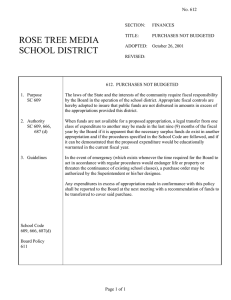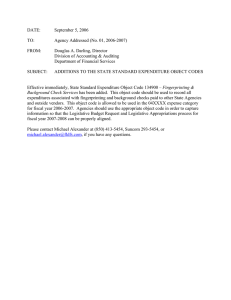Econ 741 Fall 2016 WVU Paper Topic Ideas
advertisement

Paper Topic Ideas Econ 741 WVU Public Economics I Paper Topic Ideas Fall 2016 R. D. Congleton The purpose of the final paper is to provide the student with the opportunity to write a substantial research paper in the field of public economics. Other things being equal, the more public economics and public choice tools that are applied to the topic chosen and more original and sophisticated is the analysis, the higher the grade will be. The papers can be theoretical or empirical, or better yet, combine elements of both methodologies. Style counts, because good reasoning is best demonstrated by clear, well-organized prose. All papers should be typed double spaced, fifteen to twenty two pages in length, with 12 pt or 13 pt fonts and 1 inch margins. Complete references should appear in a bibliography at the end of the paper. (The papers can be longer if necessary. A standard journal article runs 28-30 pages in manuscript form.) Some possible applications of the tools developed in class include: 1. Public Choice / Political Economy of Public Policy w w w w w Choose a government service (roads, education, social insurance, defense, etc.) and analyze the distribution of benefits and costs associated with those programs. To what extent can that distribution of benefits and costs explain the extent of the political support for and opposition to those services? How do political institutions of various kinds (dictatorship vs. democracy, PR vs. single member districts, prime ministerial vs. presidential) affect public service levels and efficiency? Are some services likely to be affected by institutions than others? If so why? Which institutions are likely to matter (government structure, political freedom, rule of law, economic freedom, etc.)? Collect the evidence necessary to test your hypothesis, and conduct preliminary tests. [For empirical tests, it is often useful to discover a “natural experiment” in which two countries or two regions differ only with respect to the “treatment” (institutional difference). At the national level, such narrow differences may be said to exist for east and west Germany, north and south Korea, Hong Kong, Taiwan and China, etc. However, even if such natural experiments do not exist for the service or institution of interest, a variety of statistical methods can be used to explore cases in which such variations exist.] 2. Public Goods and Externalities w w w w w w [Positive] Choose some public good , commons, or coordination problem and discuss the likely method(s) that a democratic (or authoritarian) polity would use to “solve” these problems. Does your theory imply that the methods (or extent) vary with median or average income, production costs, economic or political freedom, etc.? Collect the data necessary to test your hypothesis and undertake preliminary tests. [For empirical tests, it is often useful to discover a “natural experiment” in which two similar countries, two regions of the same country, or two time periods of the same region differ only with respect to the “treatment” of interest (institutional or other difference). However, a variety of statistical methods can be used to explore cases in which such variations exist.] [Normative] Contrast politically feasible or likely solutions to public goods problems with economically efficient solutions. Are some “solutions” worse than the problems addressed? For example, environmental problems are essentially all externality commons problems. Are the policies in place to address specific environmental problems Pareto efficient? If not, how can they be improved? Why have your suggestions NOT already been adopted? 1 Paper Topic Ideas w w In short, explain why current policies are less than ideal, or if they are ideal, explain how and why this may be a (temporary) equilibrium. What normative theory have you used to reach your conclusion? Would your conclusions differ if you used contractarian instead of utilitarian methods? 3. Fiscal Illusion w Discuss the logic and effects of fiscal illusion. Is there any limit on the extent to which such illusions can be exploited. Discuss policies that might serve to reduce fiscal illusion. To what extent might politicians attempt to use fiscal illusion to promote their own interest? How important is it that voters directly monitory the Congress, President, and the bureaucracy? w Does censorship reduce or increase fiscal illusion? w Is there evidence that the Condorcet jury theorem moderates fiscal illusion in countries with competitive electoral systems? How can such evidence be found? w 4. Tax, Expenditure, and Regulatory Incidence w w w w w Choose some real or hypothetical tax or expenditure program and carefully analysis of the incidence of the costs or benefits of the program. Note any spillover effects on other markets or individuals. Are their secondary markets or markets for raw materials that are affected by the tax or expenditure being analyzed. Discuss briefly the politics behind the program. [Examples of taxes include: income taxes, value added taxes, property taxes, food stamps, along with variations in tax preferences. Examples of expenditures include: social security, farm subsidies, property taxes, energy taxes, highway construction, defense expenditures, etc.] Show that Pigovian taxes can have an excess burden if taxes are imposed at beyond Pareto Effficient or SNB maximizing levels. Is this effect subject to empirical tests? Analyze particular taxes using state data for the US or international data from OECD countries for the tax of interest. Conduct a similar analysis of some specific regulation that affects some persons or some industries more than others. Demonstrate that you can use tools similar to those developed for taxation to analyze the incidence and deadweight loss of regulation (particularly excessive regulation). 5. Tax, Expenditure, or Regulatory Reform w Take a proposed tax or expenditure reform and analyze its pro's and con's. w Presidents routinely create blue ribbon commissions to recommend reforms of the US tax code. President Obama’s recommended reducing tax preferences generally and lowering tax rates. In what ways would a cap on mortgage deductions or health care deductions change the burden of taxation. Analyze whether such proposals tend to be politically dead on arrival--if they are. This year Ted Cruz proposed replacing the present income tax system with a 10% flat income tax (with a personal exemption) and a corporate income tax of 16%. Is there any empirical evidence about the effects of a proposed reform? If not can such evidence be created using econometric methods? If there is such evidence (as with the effect of eliminating loop wholes or reducing marginal tax rates), how can those estimates be improved? Do so. Social security and public medicine programs are seriously under funded in the US at present. Most of the states have under-funded their government pension programs. How might such future deficits generated by those programs be addressed? Are other democratic countries in a similar situation? Could such deficits become a financial crisis? Explain why or why not. How would you test your conclusions? For example, Sweden had a financial crisis in the early 1990s in part because of the expansion of its social insurance programs. How did they solve the crisis? What w w w w w 2 Paper Topic Ideas were the consequences of reforms to its social insurance programs and budget process on for example economic growth rates, average income, the distribution of income, interests rates, unemployment etc.? 6. Risk, Uncertainty, and the Welfare State Analyze the role that risks and/or crisis play in changes in the size or scope of a particular public program (defense spending, unemployment insurance, flood insurance, highway construction, building codes, etc.). For example, does an international military or terrorism crisis lead to large defense budgets? Does a flood lead to more spending on flood insurance and dikes? etceteras. w Does the program of interest tend to reduce or increase risks or simply reduce or increase losses from risks? That is to say, is there an moral hazard problem associated with the program of interest? For example, does unemployment insurance or bankruptcy law encourage taking up more risky careers? Does subsidized flood insurance induce more building near rivers and the oceans? Do “bailouts” of private firms encourage more risky investments? etceteras. w Is it possible to develop and estimate a statistical model that shows the above effects? If so collect the data to do so. w Are your results consistent with rational strategies for risk and/or crisis management? w 7. Fiscal Federalism w w w w w w w w w w [Positive Analysis] Analyze the effects of some particular example of fiscal or regulatory decentralization, that is to say division of responsibilities among local, state and national governments. Contrast some program(s) that is administered in a decentralized way with a more centralized version of the same program. [Positive] How does “yard stick” competition affect the tax and regulatory policies of nearby governments? Can spatial econometrics be used to show the effects of yardstick competition in a particular policy area, either within a single country, or within a group of countries that are linked in some way. Analyze how international variations in federal institutions affect the size and/or efficiency of government services. How do tax instruments interact with one another within and among tax authorities? How do such tax effects affect the political demand for public services within and among governments? [Normative Analysis.] Try to characterize the optimal degree of centralization for a particular service (education, trash collection, highway construction, defense, etc.) or regulatory authority (building codes, antitrust regulation, environmental protection, etc.). Is it possible to show that yardstick competition increases the efficiency of public service provision in the area of interest? Is it possible to show that yardstick competition increases the efficiency of public service provision in the area of interest? Are there political problems that prevent federal systems of governance or treaty organizations from reaching the ideal service levels? Explain why or why not? Given this, attempt to collect the data necessary to determine whether some group of countries or states are over or under centralized in the policy area of interest.. w 3 Paper Topic Ideas 8. International Public Economics w w w w w w There are wide variety of international organizations that provide public services of various kinds: NATO, the UN, the European Union, etc. How do such organizations raise revenue to pay for their services? How effectively do they provide their services? What are the limits of their ability to provide services or to address international externality and free-rider problems? Analyze the extent of free rider and/or agency problems in a particular international organization. Analyze the extent to which rent-seeking or corruption is likely to affect the agency’s allocation of effort or grants. If there are systematic governance failures, as often argued to be the case for many third world governments, can this be demonstrated empirically? If so, what steps can be taken by international agencies that could improve their policies? 9. Governmental Growth w w w w w Develop an economic/political explanation (or collection of explanations) for government growth in general or in the level of a particular program or tax (Medicare, Social Security, Defense, Public Parks, Mass Transit, etc.). Use your analysis to create a statistical model, collect the data necessary to test this explanation, and discuss the extent to which estimates are consistent with the model. Undertake a similar analysis of how a specific public program affects unrelated activities in the private sector. For example, does shifting police resources to anti-terrorism activities increase or decrease crime? Does devoting public resources to public pensions reduce private pensions or increase longevity? (Again instances in which a natural experiment exist often provide the most convincing empirical results.) Does your analysis distinguish between electoral and interest group models and/or public goods and risk management models of government growth? 10. OTHER TOPICS. Any public economics topic can be tackled, but to be sure that your project is feasible in the time available, please discuss and clear your topics with me before going too far. You can do so by simply writing up a short paragraph that explains what you plan (hope) to do. In general, I prefer project that use at least some of the tools developed in class to ones that do not use any of our tools, and I prefer novel applications and extensions of the tools to really straightforward ones. (The latter also tends to be true of journals.) 4



